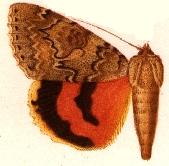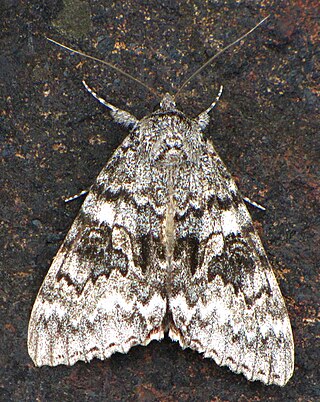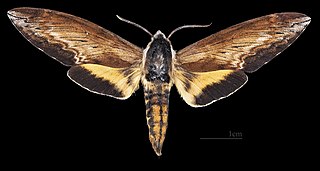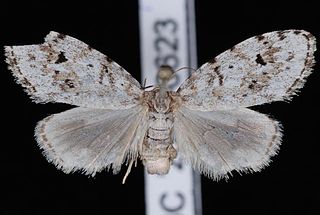
Hyalophora cecropia, the cecropia moth, is North America's largest native moth. It is a member of the family Saturniidae, or giant silk moths. Females have been documented with a wingspan of five to seven inches or more. These moths can be found all across North America as far west as Washington and north into the majority of Canadian provinces. Cecropia moth larvae are most commonly found on maple trees, but they have also been found on cherry and birch trees among many others. The species was first described by Carl Linnaeus in his 1758 10th edition of Systema Naturae.

Ferdinand Heinrich Herman Strecker was an American entomologist specialising in butterflies and moths (Lepidoptera).

Schinia, commonly called flower moths, is a large genus of moths belonging to the family Noctuidae. The genus has a Holarctic distribution with the vast majority of species being found in North America, many with a very restricted range and larval food plant.

Apantesis is a genus of tiger moths in the family Erebidae first described by Francis Walker in 1855. They are found in North and Central America.

Macaria brunneata, the Rannoch looper, is a moth of the family Geometridae. The species was first described by Carl Peter Thunberg in 1784. It is found in Siberia, Japan, and northern and mountainous parts of North America, and throughout Europe, though in Britain it is largely or entirely restricted to mature forests in central Scotland.

Tegeticula yuccasella, the yucca moth, is a moth of the family Prodoxidae. The species was first described by Charles Valentine Riley in 1872. It can be found in North America from Texas to southern Canada.

Catocala luciana, the shining underwing, is a moth of the family Erebidae. The species was first described by Herman Strecker in 1874. It is found in western North America, as far east as Minnesota and Illinois and northward into extreme southern Alberta and Saskatchewan. It occurs widely across the Great Plains, south to New Mexico, Arizona and California.

Catocala semirelicta, the semirelict underwing, is a moth of the family Erebidae. The species was first described by Augustus Radcliffe Grote in 1874. It is found in North America from Nevada, Colorado, Utah, California, and Nova Scotia south to Maine, west across Canada to British Columbia, and southward in the mountains.

Sphinx luscitiosa, or Clemens' hawkmoth, is a moth of the family Sphingidae. The species was first described by James Brackenridge Clemens in 1859. It is found in North America from Nova Scotia south to New Jersey, west through Michigan, Wisconsin and the northern plains to Alberta, Saskatchewan and Montana and south to Utah. It has been taken as far north as Yukon.

Hyalophora euryalus, the ceanothus silkmoth, is a moth of the family Saturniidae. It is found in the dry intermontane valleys and interior of British Columbia, Canada, south to Baja California in Mexico. The species was first described by Jean Baptiste Boisduval in 1855.
Brachylomia populi is a moth of the family Noctuidae first described by Ferdinand Heinrich Hermann Strecker in 1898. It is found in the inland mountains of western North America, from British Columbia and Alberta and to the south through Colorado and Utah into Arizona.

Copablepharon grandis, the pale yellow dune moth, is a moth of the family Noctuidae. The species was first described by Strecker in 1878. It is found in North America from southern Alberta east to south-western Manitoba, the eastern parts of South Dakota, North Dakota and Iowa, west to California and south to southern Arizona, New Mexico and western Texas.
Euxoa aequalis is a moth of the family Noctuidae first described by Leon F. Harvey in 1876. It is found in Canada from British Columbia, Alberta, Saskatchewan and Yukon, south into the United States, where it has been recorded from Colorado, Wyoming and California.
Euxoa dargo is a moth of the family Noctuidae first described by Ferdinand Heinrich Hermann Strecker in 1898. It is found in North America from south-eastern Manitoba west to the southern interior of British Columbia, south to Oregon, southern Idaho and northern New Mexico, and east to eastern South Dakota.

Hyalophora columbia, the Columbia silkmoth or larch silkmoth, is a moth of the family Saturniidae. In the east it is found from Quebec and Ontario to Michigan, northern Wisconsin, and south-eastern Manitoba. In the west it is found from Alberta and Montana south through the Rocky Mountains to south-western Texas and into central Mexico. The species was first described by Sidney Irving Smith in 1865.
Bandera binotella is a species of snout moth in the genus Bandera. It was described by Philipp Christoph Zeller in 1872. It is found in North America, including Texas, New Mexico, California, Colorado and Alberta.

Hyalophora is a genus of moths in the family Saturniidae. The genus was erected by James Duncan and John O. Westwood in 1841.

Clemensia albata, the little white lichen moth, is a moth of the family Erebidae. It was described by Alpheus Spring Packard in 1864. It is found in eastern North America, west across boreal Canada to south-eastern British Columbia. The range extends along the Pacific Coast south to Monterey Bay in west-central California. The habitat consists of moist forests, including coastal rainforests, oak woodlands and mixed hardwood forests.

Euscirrhopterus gloveri, the purslane moth, is an owlet moth. The species was first described by Augustus Radcliffe Grote and Coleman Townsend Robinson in 1868. It is found in North America.














